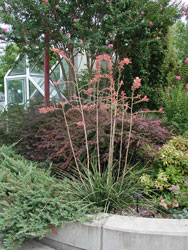Resource Library
Plant of the Week: Yucca, Red
The University of Arkansas System Division of Agriculture does not promote, support or recommend plants featured in "Plant of the Week." Please consult your local Extension office for plants suitable for your region.
Plant of the Week
Red Yucca
Latin: Hesperaloe parviflora

In the heat and drought of a typical summer, all gardeners wish for something tough that would fend for itself, but still provide color during the summer. The red yucca, Hesperaloe parviflora, an interesting plant out of the Chihuahuan desert region of the west Texas and adjacent areas of Mexico, that does just that.
Hesperaloe is a member of the Agave family that grows as an evergreen, clump-forming perennial without an above-ground stem. Its almost grass-like evergreen leaves are gray-green, semi-succulent, and narrow and 18- to 36-inches long with a white fringe of threadlike hairs along the margins. The tip of the leaf may have a blunt, hard spine. Clumps slowly expand and can spread to 3 feet or more across, but usually are much smaller.
In the early days of summer, plants begin sending up a branched inflorescence containing coral, pink or red-colored flower buds. Blossoms are about 1.5 inches long and open irregularly on the scape. The six tepals may be pinkish colored throughout, pink on the outside with a yellow throat or all yellow. Flowers are bird-pollinated and are a favorite plant for hummingbirds.
Hesperaloe translates from Latin as "western" plus "aloe." Parviflora means small flowers, at least when compared to those of a typical yucca. Botanists originally had trouble placing this plant because the leaves, fruit and seeds are yucca-like, while characteristics of the flower make it more like agave or aloe. In 1871, George Englemann, a doctor-botanist from St. Louis created the new genus Hesperaloe and solved the problem of the mixed identity. In 1894, H. parviflora was moved to the new genus, where it has remained.
There are seven species of Hesperaloe with four in or on the margins of the Chihuahan desert of northeastern Mexico and adjacent areas of the United States. The remaining three species are in the Sonoran desert west of the Sierra Madre Occidental - the spine of mountains running north and south through Mexico. It appears that the eastern and western populations of Hesperaloe at one time comprised a single continuous community that was separated as the mountain range rose to separate the plants. Over tens of millions of years, the two populations have gone on their own evolutionary way and new species have arisen from the original pool or common ancestors.
The red Hesperaloe has been grown in gardens since at least 1849 with the first catalog listing of the species appearing in the 1880s. It is so common along Texas roadsides - presumably as escapes from landscape plantings - that it has been impossible for botanists to identify its original range of the species. It will survive on as little as 10 inches of rainfall a year, making it popular throughout the southwestern states in landscapes. But, as long as the soil is well drained, it survives in garden locations receiving 50 inches of rainfall a year. In landscape situations, it is best in non-irrigated beds. It is adaptable to any average garden soil and cold-hardy to at least zero degrees Fahrenheit.
By: Gerald Klingaman, retired
Extension Horticulturist - Ornamentals
Extension News - July 9, 2010
The University of Arkansas System Division of Agriculture does not maintain lists of retail outlets where these plants can be purchased. Please check your local nursery or other retail outlets to ask about the availability of these plants for your growing area.